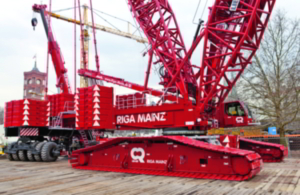
High Tech in a Medieval Town
Heavy load contractor and crane operator Hugon, based in the south of France, has purchased a Liebherr LTC 1045-3.1 compact crane to be used specially for crane jobs in towns like Narbonne and Perpignan which have narrow streets. However, driver Fabrice Bresson's greatest challenge in manoeuvring his crane through an old town's narrow streets came in a village built 800 years ago as an annex to a fortress on the edge of the Pyrenees -the mediaeval town of Carcassonne.
He brought the compact crane to a halt in front of the massive town walls just before 6 am. The world famous bastion was all quiet and tourists were still in their hotel beds. Fabrice Bresson, on the other hand, had already completed the 90-minute journey from Narbonne. French crane drivers actually bear the fine-sounding title of 'grutier' (pronounced `groutieh`), derived from `la grue`, the crane.
The driver had a few things to take care of before driving into the citadel. First of all, Fabrice moved his cab into working position. After this, the storage box in the front of the vehicle was attached to the crane hook and placed in front of the walls. This reduced the length of the vehicle by more than 120 cm.
Later, in the winding streets, he would need every centimetre of this reduction. The flashing light on the ballast block was unscrewed and the telescopic boom lowered. The exterior mirrors were also moved in and then Fabrice, the grutier, moved his 2.5 m power pack towards the first gate.
Slowly and steadily
He had brought two marshals with him to help him manoeuvre through the mediaeval town, one of them being Christophe VergFs, a member of the technical staff at Hugon. The passage through the outer ring of the fort, the Porte Narbonnaise, is around 25 m long and consists of four gates. Because the last of them is offset at an angle of around 45?, the most demanding obstacle for the driver is a tight S-bend right at the start of the course.
So the three men had no time to warm up. Instead, the crane was set to crab steering speed, all-wheel steering and independent rear axle steering. A total of five steering programmes give the vehicle great manoeuvrability and extremely small turning circles. As it passed through the final stone gate, the crane seemed to move in slow motion. All the time, Christophe VergFs was using his thumb and forefinger to show the distance to the massive walls. His digits moved closer and closer together. Finally he stopped the 45-tonne crane which looked as though it was wedged. The men discussed the situation briefly. Then the LTC passed the point carefully without touching the stones.
The crane braked again at the second town wall in front of the smallest and lowest gate into the citadel. The pointed arch of the old gate starts to narrow almost at the bottom. A low-hanging lantern was swinging in the wind. From here, the clearance height in Carcassonne is limited to just 3 m. To achieve this, Fabrice telescoped his driver's cab forwards into the lower road position. He also retracted the cylinders on the hydro-pneumatic suspension by 100 mm. Lowered to this position, the crane slipped through the dark gate as if it was bent double.
The next step
Now the road led steeply upwards. Tavern signs, sun awnings, road lights and extending parts of buildings dictated the vehicle's speed. The three men continued to concentrate hard on getting their 36-tonne vehicle through each narrow point. 'Carcassonne is actually a UNESCO World Heritage Site. Making a mistake like touching the walls was simply unthinkable', said Christophe VergFs during a brief stop. At a small square, the crane was overtaken by craftsmen's cars and lots of small delivery vans. The city crane would block a major route for the whole day. Everybody had been informed and was hurrying to get through before the crane started work.
Thirty minutes after entering the citadel, the compact crane had finally reached its destination. It had travelled around 400 m during this time. The small erection area at the site was just big enough for a vastly reduced support base. The actual crane job was a good deal less spectacular. Two distributor boxes weighing around one tonne each had to be raised onto a flat roof and the old ones taken down but the fitters on the roof had problems with the installation work which appeared to take forever. A storm had been forecast for the night and a strong wind had already started to blow. The grutier sent several worried glances to the sky. His crane had to be out of the mediaeval town by evening because his licence was for a limited time. The craftsmen were already waiting in their cars impatiently for the narrow streets to be clear again when the crane finally retracted its telescopic boom. The Hugon team packed everything away.
The return route was a little more troublesome than the trip in the morning. The shops were still open and lots of visitors were moving around the narrow streets of the town despite the sharp wind and low temperatures. That meant that the two marshals not only had to help the crane driver but also had lots of other things to do. Souvenirs were cleared from the cobblestones, boxes of vegetables removed and sun awnings retracted. And despite the four accompanying policemen, curious tourists continually walked in front of the city crane, taking photographs and filming the incredible scenes.
It was not until late in the evening that Fabrice, our grutier, finally parked his crane in the Hugon yard in Narbonne, bringing an unusual working day to an end.


 +91-22-24193000
+91-22-24193000 Subscriber@ASAPPinfoGlobal.com
Subscriber@ASAPPinfoGlobal.com